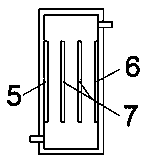Device and method for removing ammonia nitrogen, nitrite nitrogen and COD in marine culture wastewater
A marine aquaculture and nitrous nitrogen technology is applied in the field of devices for removing ammonia nitrogen, nitrite nitrogen and COD from marine aquaculture wastewater, and can solve problems such as the inability of the biological method to be lasting and stable, the poor resistance to adverse environmental impact, and the regeneration of adsorbents. , to achieve good development prospects, easy operation and maintenance, fast removal rate
- Summary
- Abstract
- Description
- Claims
- Application Information
AI Technical Summary
Problems solved by technology
Method used
Image
Examples
Embodiment 1
[0041] combine figure 1 and figure 2 Shown, the method for electrochemically removing ammonia nitrogen, nitrite nitrogen and COD in mariculture wastewater is carried out in the following steps:
[0042] 1. The wastewater discharged from the mariculture wastewater is collected and enters the reservoir 1;
[0043] 2. The outlet water of the reservoir 1 enters the electrochemical reactor 3 equipped with the anode 5, the bipolar electrode 7 and the cathode 6 through the peristaltic pump 2, starts the DC stabilized power supply 4, and enters the water from the bottom to the top. The parallel placement of the electrodes can ensure sufficient and uniform contact between the electrodes and the aqueous solution;
[0044] 3. In the electrochemical reactor 3, a large amount of Cl in the aqueous solution - Oxidized to Cl at the anode 2 , the generated Cl 2 Dissolved into aqueous solution to generate HOCl, wherein HClO is also ionized to generate ClO - . Free chlorine (including Cl...
Embodiment 2
[0052] Compared with Example 1, the treatment method is only different in that the current density is 4mA / cm 2 .
[0053] After testing, the concentrations of ammonia nitrogen, nitrite nitrogen and COD before and after treatment are shown in Table 2.
[0054] Table 2: Concentrations of typical ammonia nitrogen, nitrite nitrogen and COD before and after treatment (mg / L)
[0055]
Embodiment 3
[0057] Compared with Example 1, the treatment method differs only in that the initial concentrations of ammonia nitrogen, nitrite nitrogen and COD are different.
[0058] After testing, the concentrations of ammonia nitrogen, nitrite nitrogen and COD before and after treatment are shown in Table 3.
[0059] Table 3: Concentrations of typical ammonia nitrogen, nitrite nitrogen and COD before and after treatment (mg / L)
[0060]
[0061]
PUM
 Login to View More
Login to View More Abstract
Description
Claims
Application Information
 Login to View More
Login to View More - R&D
- Intellectual Property
- Life Sciences
- Materials
- Tech Scout
- Unparalleled Data Quality
- Higher Quality Content
- 60% Fewer Hallucinations
Browse by: Latest US Patents, China's latest patents, Technical Efficacy Thesaurus, Application Domain, Technology Topic, Popular Technical Reports.
© 2025 PatSnap. All rights reserved.Legal|Privacy policy|Modern Slavery Act Transparency Statement|Sitemap|About US| Contact US: help@patsnap.com



